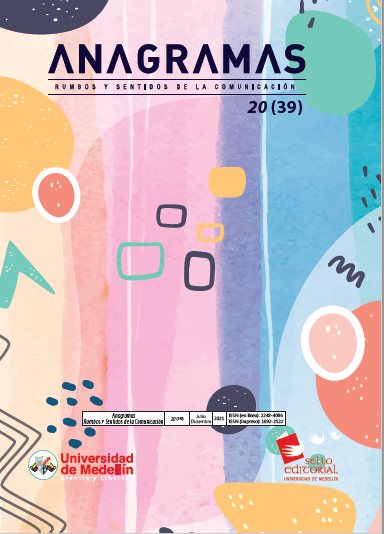Derechos de autor 2023 Anagramas Rumbos y Sentidos de la Comunicación

Esta obra está bajo licencia internacional Creative Commons Reconocimiento-NoComercial-SinObrasDerivadas 4.0.
- Articles
- Enviado: diciembre 2, 2020
-
Publicado: agosto 6, 2021
Resumen
El artículo responde a la investigación titulada Evolución e impacto de la red social Facebook como medio de comunicación masiva de las organizaciones campesinas del Catatumbo, Ascamcat y Cisca, desarrollada para identificar las dinámicas existentes en el uso del medio social como una herramienta de difusión de las actividades propias de las organizaciones citadas, teniendo en cuenta la importancia de sus acciones mediáticas en la subregión del departamento Norte de Santander, el Catatumbo colombiano, de allí la relevancia para los habitantes del lugar, quienes pueden aprovechar la herramienta en su progreso social.
La investigación recolectó datos cualitativos por medio de observación y entrevistas semiestructuradas, dando lugar a la comprensión que la Web 2.0 trajo, y así determinar las dinámicas producto del uso de Facebook como medio de comunicación por parte de las organizaciones campesinas del Catatumbo, scamcat y Cisca.
Para la Asociación Campesina del Catatumbo y el Comité de integración Social del Catatumbo, Facebook es una herramienta que apoya tres ejes: visibiliza las actividades desarrolladas por cada organización; muestra las realidades propias de la región integrada por once municipios en el departamento Norte de Santander; y desmiente o contrarresta informaciones emitidas por los medios de comunicación masiva del orden departamental y nacional.
Por consiguiente, aunque la red social virtual no fue creada ni diseñada para ser un medio de comunicación
masiva, en esencia se convierte en la ventana que permite mostrar las realidades del Catatumbo, desmintiendo en algunos casos el discurso hegemónico de los tradicionales medios, radio, prensa y televisión.
Referencias
- Ascamcat. (2018). Información de los seguidores de la Asociación Campesina del Catatumbo. [página de Facebook]. Facebook. Consultado el 26 de mayo de 2018. https://www.facebook.com/search/top/?q=ascamcat%20-%20oficial
- Becerra, M. (2014). Medios de comunicación: América Latina a contramano. Nueva Sociedad, (249). https://nuso.org/articulo/medios-de-comunicacion-america-latina-a-contramano/
- Blanchet, K. (2001). La gobernabilidad y sus críticos. El desarrollo participativo, entre deseos y realidades. Revista Internacional de Ciencias Sociales, (170). http://www.unesco.org/new/fileadmin/MULTIMEDIA/HQ/SHS/pdf/170-fulltext170spa.pdf
- Castells, M. (2009). Comunicación y poder. Alianza Editorial. https://www.felsemiotica.com/descargas/Castells-Manuel-Comunicaci%C3%B3n-y-poder.pdf
- Cisca. (2018). Información de los seguidores del Comité de Integración Social del Catatumbo [página de Facebook]. Facebook. Consultado el 26 de mayo de 2018. https://www.facebook.com/cisca.comunicaciones/
- Colombia TIC. (2018). Estadísticas Puntos Vive Digital en Norte de Santander. https://colombiatic.mintic.gov.co/679/w3-propertyvalue-36366.html
- Duarte, F. y Pires, H., F. (2011). Inclusión digital, tres conceptos clave: conectividad, accesibilidad, comunicabilidad. https://revistes.ub.edu/index.php/aracne/article/view/26674
- De Certeau, M. (1990). La invención de lo cotidiano. Universidad Iberoamericana Biblioteca Francisco Xavier Clavigero. https://monoskop.org/images/2/28/De_Certeau_Michel_La_invencion_de_lo_cotidiano_1_Artes_de_hacer.pdf
- De Ugarte, D. (2007). El poder de las redes. http://www.pensamientocritico.org/davuga0313.pdf
- De Pablos C., J. M. (1999) Es que vamos hacia una sociedad de la información. Latina, Revista de Comunicación Social, (14). https://dialnet.unirioja.es/servlet/articulo?codigo=1214182
- Facebook. (2021). Misión de la red social virtual Facebook. https://about.facebook.com/company-info/
- Gómez M., C. (2015). Nuevas aproximaciones a la teoría de los usos sociales: Prioridades para comprender los procesos de apropiación de las TIC en sociedades diversas. Visiones interdisciplinarias de la diversidad cultural. Colección del Seminario de Investigación sobre sociedad del conocimiento y diversidad cultural de la UNAM. https://www.academia.edu/27589964/Visiones_Interdisciplinarias_de_la_Diversidad_Cultural?auto=download
- Harto de Vera, F. (2006). Tipologías y modelos de democracia electrónica. Revista de Internet, Derecho y Política, 2.
- Hernández-Sampieri, R., Fernández-Collado, C. y Baptista-Lucio, P. (2014). Metodología de la Investigación. Interamericana Editores
- Kaplún, M. (2002). Una pedagogía de la comunicación, el comunicador popular. Ediciones Ciespal. http://www.aader.org.ar/admin/savefiles/352_Mario%20Kaplun.pdf
- Max-Neef, M. (1993). Desarrollo a escala humana. Nordan comunidad. http://www.max-neef.cl/descargas/Max_Neef-Desarrollo_a_escala_humana.pdf
- Mejía, C., G. (2016). Las organizaciones sociales que mueven el Catatumbo. Verdad Abierta. http://www.verdadabierta.com/victimas-seccion/los-resistentes/6341-las-organizaciones-socialesque-mueven-el-catatumbo
- Monterde, A., Rodríguez, A. y Peña-López, I. (2013). La reivindicación de la democracia en la sociedad red, neutralidad de la red, ética hacker, cultura digital, crisis institucional y nueva institucionalidad. Working Paper Series WP13, 004. Internet Interdisciplinary Institute. http://tecnopolitica.net/sites/default/files/1774-6278-4-PB.pdf
- Nagel, J. (2012). Principales barreras para la adopción de las TIC en la agricultura y en las áreas rurales. Comisión Económica para América Latina y el Caribe (Cepal). http://repositorio.cepal.org/bitstream/handle/11362/4011/S2012079_es.pdf?sequence=1
- Organización de las Naciones Unidas para la Alimentación y la Agricultura (FAO). (1994). Participación Campesina para una Agricultura Sostenible en Países de América Latina. http://www.fao.org/3/t3666s/t3666s04.htm#:~:text=Las%20organizaciones%20campesinas%2C%20tambi%C3%A9n%20llamadas,o%20sociales%20de%20sus%20miembros.
- Paquienséguy, F. (2007). Las Tecnologías de la Información y la Comunicación y sus usos hoy. Revista Q, 1(2). https://repository.upb.edu.co/bitstream/handle/20.500.11912/6490/Las%20tecnolog%C3%ADas%20de%20informaci%C3%B3n%20y%20comunicaci%C3%B3n%20y%20sus%20usos.pdf?sequence=1&isAllowed=y
- Simon, J. P. (2016). La transformación digital, nuevos agentes en la industria de los medios y contenidos. Revista Telos, Cuadernos de Comunicación e Innovación. https://telos.fundaciontelefonica.com/archivo/numero103/nuevos-agentes-en-la-industria-de-los-medios-y-contenidos/





























